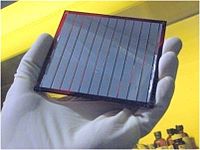Organic solar cell

Imagine you have a special toy that can capture the sun's energy and use it to light up your room. Now, imagine that scientists have found a way to make something similar using tiny materials that can convert sunlight into electricity.
Organic solar cells are like those materials. They are made of thin layers of plastic-like materials that can take in light and convert it into electrical energy.
These solar cells work by having different layers of materials with different electrical properties stacked on top of each other. When sunlight hits the cell, some of it is absorbed and excites the electrons in the materials. The excited electrons jump from one layer to another and can be harnessed to create electrical energy.
This type of solar cell is named "organic" because the materials used in it are made from carbon atoms, which are the building blocks of life. Organic solar cells are flexible, lightweight, and can be made into a variety of shapes and colors.
The cool thing is that organic solar cells can be made into large sheets and rolled up like a carpet. This means that they can be easily transported and installed in places where traditional solar panels can't fit, like on backpacks or on curved surfaces.
Overall, organic solar cells are a great way to generate renewable energy and reduce our dependence on fossil fuels. They are also an exciting area of research, as scientists continue to find new ways to improve their efficiency and make them more accessible to everyone.
Organic solar cells are like those materials. They are made of thin layers of plastic-like materials that can take in light and convert it into electrical energy.
These solar cells work by having different layers of materials with different electrical properties stacked on top of each other. When sunlight hits the cell, some of it is absorbed and excites the electrons in the materials. The excited electrons jump from one layer to another and can be harnessed to create electrical energy.
This type of solar cell is named "organic" because the materials used in it are made from carbon atoms, which are the building blocks of life. Organic solar cells are flexible, lightweight, and can be made into a variety of shapes and colors.
The cool thing is that organic solar cells can be made into large sheets and rolled up like a carpet. This means that they can be easily transported and installed in places where traditional solar panels can't fit, like on backpacks or on curved surfaces.
Overall, organic solar cells are a great way to generate renewable energy and reduce our dependence on fossil fuels. They are also an exciting area of research, as scientists continue to find new ways to improve their efficiency and make them more accessible to everyone.
Related topics others have asked about:
